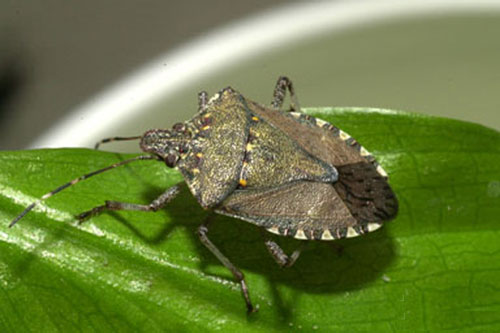 Photo by David R. Lance, USDA APHIS PPQ, Bugwood.org
Photo by David R. Lance, USDA APHIS PPQ, Bugwood.org
 Photo by David R. Lance, USDA APHIS PPQ, Bugwood.org
Photo by David R. Lance, USDA APHIS PPQ, Bugwood.org
Over the last few years, we’ve seen a tremendous increase in Brown Marmorated Stink Bug (Halyomorpha halys) in our homes and our gardens. These large, shield-shaped insects are an exotic & invasive insect native to Asia. It is important not to confuse these alien invaders with our native stink bug, whose population is kept in check by natural predators and poses no significant threat to our landscape.
The invasive stink bugs feed on a wide variety of plants, and can be destructive on apple, pear, cherry, grape, raspberry, bean, sweet corn, tomato, field corn, and soybean crops. Ornamental landscape plants that are at risk include linden (aka Basswood) trees, butterfly bush, catalpa, cherry trees, honeysuckle, mulberry, redbud, rose, silver maple, sweet gum, and walnut trees. In home gardens, stinkbugs tend to pierce ripening tomatoes to feed on the juices, which ruins fruit and can cause bacterial rot & other problems.
Most homeowners are troubled when these pests fall out of their ceiling tiles, emerge from the vacuum cleaner, or crawl out from trim and cupboards at all times of the year. At least 28 counties in Wisconsin have confirmed reports, and the spread is continuing.
The best way to keep stink bugs out of your home is to prevent them from establishing a colony in the first place. Once established, they are very difficult to thoroughly remove. Snug fitting door sills and window trim are important. Correct use of weather stripping and caulk is important, as well as checking vents and screens for tears.
Adult stink bugs are confirmed hitchhikers! Leaving car windows open invites these pesky insects along for a ride, and their colonization of the upper Midwest seems to follow major interstate corridors (for more info: https://insectlab.russell.wisc.edu/2018/11/19/bmsb-2018/)
As of 2020, breeding populations have not been confirmed in Wisconsin. Adults appear to overwinter in protected sites, and become active when temperatures warm in spring. In areas with established breeding colonies, mating and egg-laying occur from May through early fall.
So how can they be killed? At this point, there are no biological controls that are effective on this non-native insect. Many over-the-counter insecticide labels have not been updated to include suggestions specific to stink bugs, but our local knowledge is growing. Stop into our shop to discuss chemical options for point-of-entry control!
Retail Hours
Sun: 10:00am - 3:00pm
Mon: CLOSED
Tue: 9:00am - 6:00pm
Wed: 9:00am - 6:00pm
Thu: 9:00am - 6:00pm
Fri: 9:00am - 6:00pm
Sat: 9:00am - 4:00pm